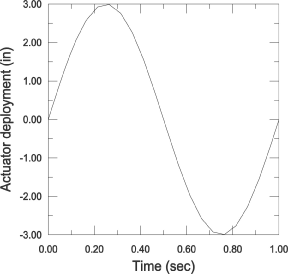Geometry and model
The complete model of the flap is shown in Figure 1. An actuator rotates a bell crank through the deployment of an actuator arm. The bell crank pushes and pulls a connecting rod that attaches to the arm of the flap.
The flap is connected to a rigid shaft on the aircraft wing structure at points E and I. An arm on the shaft is attached to the rod at point F. The other end of the rod attaches to a bell crank at point D. The bell crank is attached to the airplane so that it can rotate about point B. The axis of rotation of the bell crank passes through point B and is parallel to the global Z-axis. The rotation of the bell crank is driven by the deployment of the actuator arm. The actuator system attaches to the bell crank at point C. The other end of the actuator system is attached to the aircarft structure at point A and is allowed to compensate for the change of angle caused by the rotation of the bell crank.
A load is applied at the center of gravity of the flap so that it is colinear and oriented along the global Z-axis.


